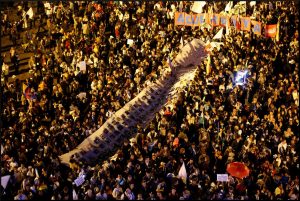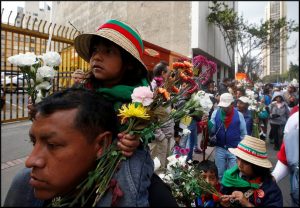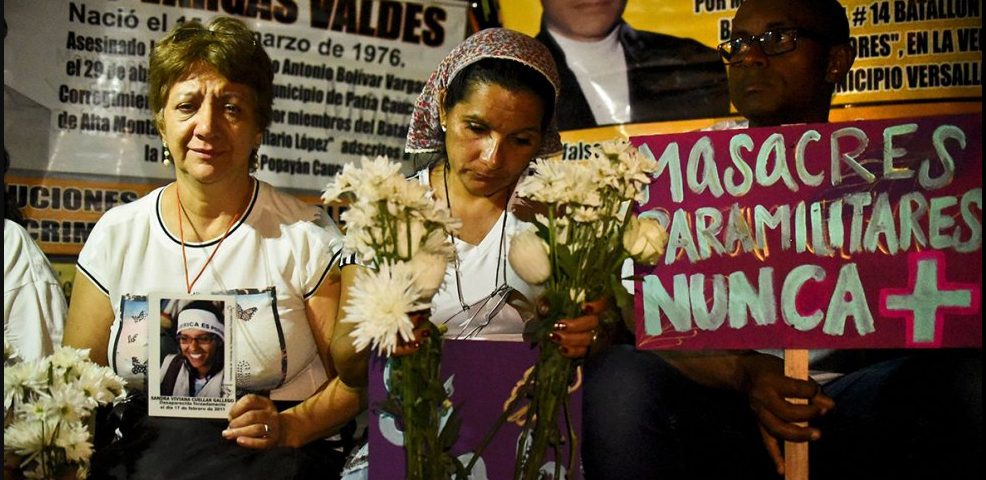Editor’s Note: If you have been following the MSM on Columbia, you may think the peacemaking initiatives in Columbia are working towards a just future for the Colombian people rather than an extension of the pacification policies of the past. You need to think again.
Alliance for Global Justice Fact Sheet to support the August Days for Peace in Columbia.
About Colombia’s civil war:
- The Colombian Congress approved peace accords on November 30, 2016, ending over 52 years of civil war with the Revolutionary Armed Forces of Colombia-People’s Army (FARC-EP). That war began on May 27, 1964, when one third of the Colombian Army, supplied by the US government, attacked the peasant autonomous zone of Marquetalia.
- Colombia’s armed conflict has claimed over 220,000 lives, 92,000 people have been disappeared, and 7.7 million forcibly displaced. Colombia has the world’s largest population of internally displaced.
- Throughout this war, at any point, 70 to 85% of violence has been committed by paramilitary death squads and/or Colombian Armed Forces. The same percentage holds regarding human rights abuses.
The peace process is in serious trouble:
- According to the Colombian organization Indepaz, there have been 385 social movement leaders and human rights defenders killed since January 1, 2016, 283 of those since the peace accords went into effect. The Marcha Patriótica popular movement for a just peace reports that 161 of those murdered since January 2016 were from its membership.
- The peace accords turned the FARC-EP into a legal party, the Revolutionary Alternative Force of the Common (FARC). The accords have five major points – rural reform, political participation, end of the armed conflict, narco-trafficking, and victims of the conflict. The FARC is now completely disarmed and has fulfilled 100% of its obligations. The Colombian government, has passed only 20% of minimum legislation needed to implement the accords. In each of the major points, the government is failing to meet its obligations. Now there is proposed legislation to repeal some of the most central agreements.

War and repression in Colombia is made in the USA:
- The current political violence in Colombia is terrorism, and the US government is behind it. In 1962, a Pentagon commission headed by Lt. Gen. William P. Yarborough urged Colombia to “execute paramilitary, sabotage and/or terrorist activities backed by the United States”.
- Plan Colombia has cost US taxpayers over $11 billion, the vast majority of the funds going to the Colombian Armed Forces and “security” apparati. Plan Colombia has even given out hundreds of thousands of dollars to support palm oil mega-farms owned by paramilitary death squad commanders
- The US government is attacking the accords on several fronts. The White House and Pentagon are urging Colombia to end rural development and crop substitution programs to replace illicit crop cultivation, favoring, instead, violent forced eradication.
- The White House also maintains a policy of seeking extradition of FARC-EP peace negotiators in violation of peace accords. This includes a request for the extradition of Jesús Santrich, based on flimsy evidence and the testimony of agents and paid informers.
The violence happening now in Colombia is a form or US backed terrorism:
- Colombia’s oligarchy and extreme right wing are systematically trying to exterminate Colombia’s Left and popular movements, especially those based in Afro-Colombian, indigenous, and peasant communities. Center-Left and Left parties, members of the Marcha Patriótica, and social activists are being assassinated at a rate of more than one per day. At least 7.7 million people have been forcibly displaced since 1985, and today forced displacement is increasing.
Colombia is portrayed as an example of democracy for Latin America, but the evidence says otherwise:
- During the 2018 electoral campaigns, the new, disarmed, and legal FARC political party as well as the Center-Left Colombia Humana, were repeatedly threatened and attacked by paid thugs. Congressional elections in March 2018 were marred by a shortage of ballots in over 20% of Colombia’s voting system, including the country’s three largest cities.
- The Electoral Observation Mission of Colombia reported 1,290 campaign violations. One election day poll reported that 30% of Colombian voters said they were not able to vote privately. During the first round of the presidential vote, Alliance for Global Justice observers witnessed irregularities including attempts to buy votes, alteration of voting observer credentials, and ejection Colombia Humana observers from polling stations. That vote was preceded by widely publicized paramilitary warnings for Colombia Humana supporters not to come to polls, and by several murders of campaign workers and prominent activists.
- Colombia’s new president, Ivan Duque, is a disciple of former president Álvaro Uribe, patron of the paramilitaries, who was listed by the US Defense Intelligence Agency as one of Colombia’s top 100 narco-traffickers. Duque has called Uribe Colombia’s “eternal president”.

A few basic social indicators:
- Colombia has almost 50 million people, with 76% living in urban areas. Just over 26% of the population are 15 years old and under, and almost two thirds are between 15 and 65.
- Various sources put the percentage of Colombians who live below the poverty line between 27 and 34%. More than 12.7% of Colombians live on less than $2 a day. Over 7 million rural Colombians live in poverty, 2 million in extreme poverty.
- Some regions, like La Guajira, are especially affected by poverty. According to the National Health Institute, 770 children died from preventable diseases in 2017, with 192 dying from malnutrition, most in La Guajira. Malnutrition deaths have gone up so far in 2018. Between 2006 and 2016, 4,770 indigenous children in La Guajira died from malnutrition.
- Overall, Colombia’s poverty rate has steadily decreased over the last 15 years except for a slight increase in 2016. However, in Bogotá, with a population of over 8 million people, the poverty rate has climbed the last three years. Bogotá has absorbed a large number of the forcibly displaced.
- Colombia has the second most unequal distribution of income in Latin America, after Brazil.
- Some level of health care access extends to most the Colombian population. However, it is severely limited in many rural areas. Among majority Afro-Colombian areas like Chocó, and cities like Buenaventura and Tumaco, access to health care is extremely limited, and a majority of the populations do not have access to running, potable water.
This fact sheet is provided by the Alliance for Global Justice.
To get more information, visit us at: www.afgj.org or give us a call at 202-544-8336
** Images are from International Business Times, 2016
